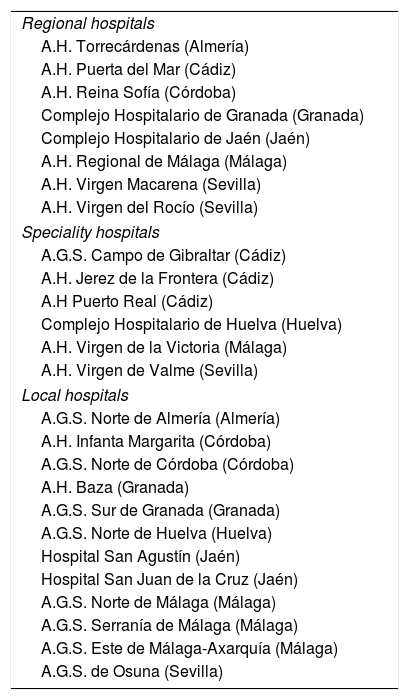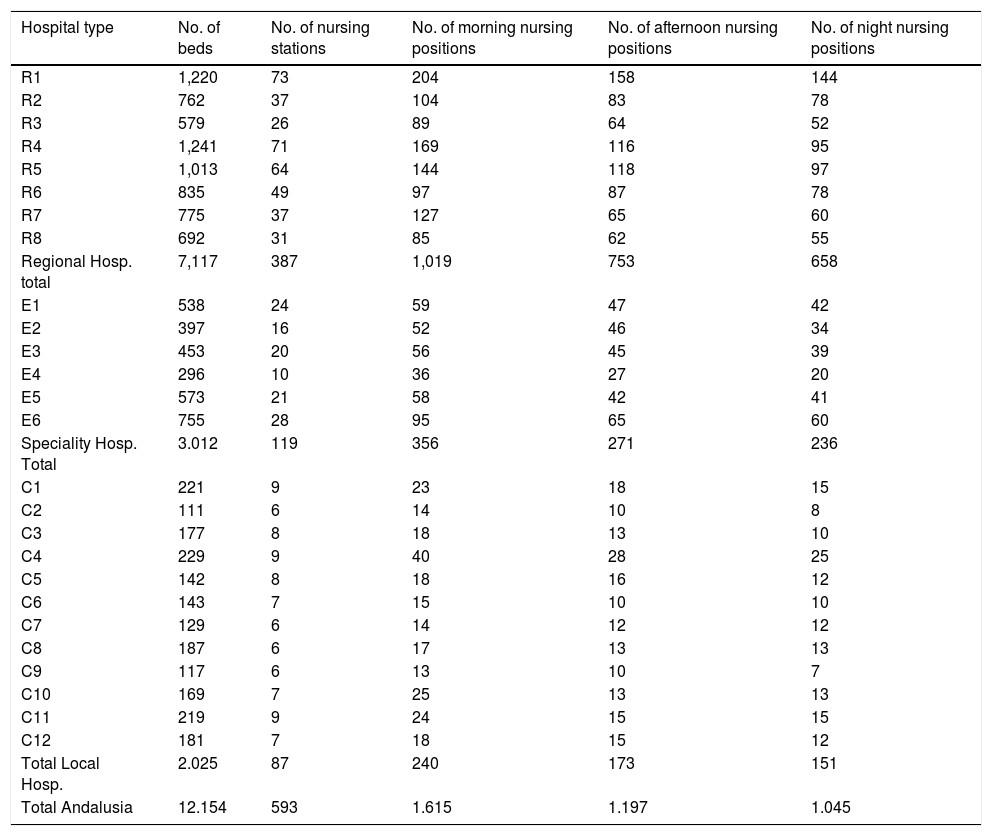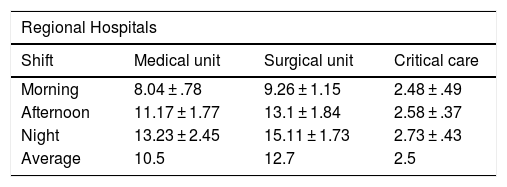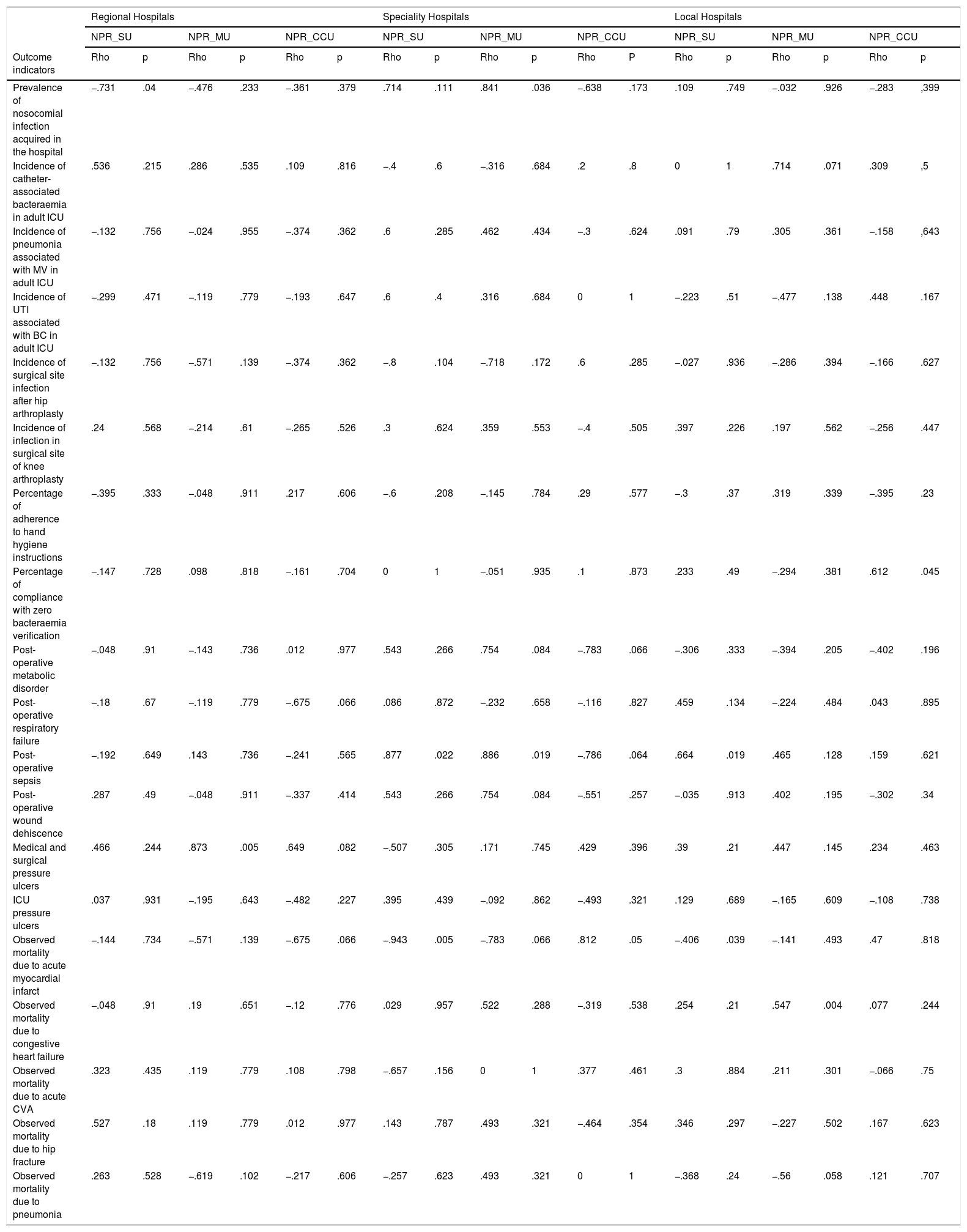To analyse the patient-nurse ratio and its association with health outcomes in public hospitals of the Andalusian Health Service (SAS).
MethodCross-sectional ecological study carried out in adult units of 26 Andalusian public hospitals. Data on structure (beds, type of unit, nursing control), management (average stay, index of use of stays, complexity index) and nursing staff were collected. They were extracted from official sources: CMBDA, SAS/Health Council (CS) publications and specific respondents to Nursing Directorates. The patient-nurse ratio was calculated and related to 19 indicators of hospital quality, safety, and mortality. Measures of central tendency and Spearman's correlation coefficient were used for statistical analysis.
ResultsA response was obtained from 100% of the Andalusian hospitals. The average patient-nurse ratio in the three shifts was lower in hospitals with a broader portfolio of services-regional scope (11.6), followed by those with a medium portfolio-specialties (12.7) and hospitals with a basic portfolio-county (13.5). By type of unit, the medical units were 11.8 (SD = 1.8) lower than the surgical ones 13.5 (SD = 2.7). Significant differences were only found in medical units of regional hospitals 10.5 (SD = 1.4) and district hospitals 13.03 (SD = 1.46) (p = .001). In critical care, the ratio was greater than 2 patients per nurse in the three groups. When relating the ratio to health outcomes, 5 significant associations were found: pressure ulcers (p = .005), prevalence of nosocomial infections (p = .036), postoperative sepsis (p = .022), zero bacteraemia verification (p = .045) and mortality from heart failure (p = .004).
ConclusionsThe results indicate a high patient-nurse ratio in adult hospitalization units and that there is a positive association between the patient-nurse ratio and worse results related to nursing care.
Analizar la ratio paciente-enfermera y su asociación con los resultados en salud en hospitales públicos del Servicio Andaluz de Salud (SAS).
MétodoEstudio ecológico transversal realizado en unidades de adultos de 26 hospitales públicos andaluces. Se recogieron datos de estructura (camas, tipo de unidad, control de enfermería), de gestión (estancia media, índice de utilización de estancias, índice de complejidad) y de dotación enfermera. Fueron extraídos de fuentes oficiales: CMBDA, publicaciones de SAS/Consejería de Salud (CS) y específicos demandados a Direcciones de Enfermería. Se calculó la ratio paciente-enfermera y se relacionó con 19 indicadores de calidad hospitalaria, seguridad y mortalidad. Para el análisis estadístico se utilizaron medidas de tendencia central y el coeficiente de correlación de Spearman.
ResultadosSe obtuvo respuesta del 100% de los hospitales andaluces. El promedio de ratio pacientes-enfermera en los 3 turnos fue menor en hospitales con cartera de servicios más amplia-ámbito regional (11,6), seguido de los de cartera media-especialidades (12,7) y los hospitales con cartera básica-comarcales (13,5). Por tipo de unidad, en las médicas fue menor 11,8 (DE = 1,8) respecto a las quirúrgicas 13,5 (DE = 2,7). Solo se hallaron diferencias significativas en unidades médicas de los hospitales regionales 10,5 (DE = 1,4) y comarcales 13,03 (DE = 1,46) (p = 0,001). En cuidados críticos la ratio fue mayor de 2 pacientes por enfermera en los 3 grupos. Al relacionar la ratio con resultados en salud se hallaron 5 asociaciones significativas: úlceras por presión (p = 0,005), prevalencia de infecciones nosocomiales (p = 0,036), sepsis postoperatoria (p = 0,022), verificación bacteriemia zero (p = 0,045) y mortalidad por insuficiencia cardíaca (p = 0,004).
ConclusionesLos resultados indican una ratio paciente-enfermera elevada en las unidades de hospitalización de adultos y que existe una asociación positiva entre la ratio paciente-enfermera y peores resultados relacionados con los cuidados enfermeros.












